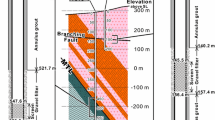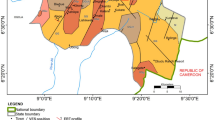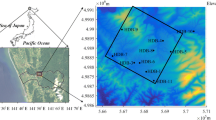Abstract
The largest undeveloped uranium deposit in the United States, at Coles Hill, is located in the Piedmont region of Pittsylvania County, south-central Virginia, and is hosted in crystalline rocks that are adjacent to and immediately west of Chatham Fault, which separates these crystalline rocks from the metasedimentary rocks of the Danville Triassic Basin (in the east). Groundwater at the site flows through a complex network of interconnected fractures controlled by the geology and structural setting. The role of Chatham Fault in near-surface (<≈200 m) groundwater flow is examined using electrical resistivity profiling, borehole logging, a pumping test, groundwater age dating and water chemistry to determine if the fault represents a permeability barrier or conduit for groundwater flow. The volumetric flow per unit width flowing eastward across the fault is estimated at 0.069–0.17 m2/day. Geochemical data indicate that groundwater in the granitic crystalline rocks represents a mixture of modern and old water, while the Triassic basin contains a possible deeper and older source of water. In regions with shallow water tables, mine dewatering during operation presents significant mining costs. The study’s results yield important information concerning the effect that Chatham Fault would have on groundwater flow during Coles Hill mining operations.
Résumé
Le plus grand gisement d’uranium non exploité aux Etats unis, à Coles Hill, est localisé dans la région de Piémont de Pittsylvania County, centre Sud de Virginie, et encaissé dans des roches cristallines immédiatement adjacentes à l’Ouest de la Faille Chatham, qui sépare ces roches cristallines des roches sédimentaires du bassin triasique de Danville (à l’Est). Sur le site, la nappe s’écoule à travers un réseau complexe de fractures interconnectées contrôlées par la géologie structurale. Le rôle de la faille Chatham dans l’écoulement de sub surface (<≈200 m) est examiné en utilisant profil de résistivité électrique, diagraphie, un test de pompage, datation de l’eau de nappe et chimie de l’eau, pour déterminer si la faille représente une barrière hydraulique ou un conduit pour l’écoulement souterrain. Le débit par unité de surface s’écoulant en direction de l’Est d’un côté à l’autre de la faille est estimé à 0.069–0.17 m2/jour. Des données géochimiques indiquent que l’eau de nappe dans la roche granitique représente un mélange d’eau récente et ancienne, tandis que le bassin triasique contient une eau pouvant être plus profonde et plus ancienne. Dans les régions à surface de nappe libre peu profonde, l’exhaure pendant l’extraction représente des coûts d’exploitation considérables. Les résultats de l’étude fournissent des informations importantes concernant l’incidence que la Faille Chatham aurait sur le flux souterrain pendant l’exploitation minière de Coles Hill.
Resumen
El mayor depósito de uranio sin explotar en los Estados Unidos, en el Coles Hill, está situado en la región del piedemonte del Condado de Pittsylvania, centro sur de Virginia, y está alojado en rocas cristalinas localizadas inmediatamente al oeste y adyacentes a la falla de Chatham, que separa estas rocas cristalinas de las rocas metasedimentarias de la cuenca Triásica de Danville (en el este). El agua subterránea en el sitio fluye a través de una compleja red de fracturas interconectadas controladas por la configuración geológica y estructural. Se examina el rol de la falla de Chatham en el flujo subterráneo cercano a la superficie (<≈200 m) usando perfilajes de resistividad eléctrica, registros de perforaciones, un ensayo de bombeo, datación de la edad del agua subterránea y la química del agua para determinar si la falla representa una barrera permeable o un conducto para el flujo del agua subterránea. El flujo volumétrico por unidad de ancho que fluye hacia el este a través de la falla está estimado en 0.069–0.17 m2/día. Los datos geoquímicos indican que el agua subterránea en las rocas graníticas cristalinas representa una mezcla de agua moderna y antigua, mientras que la cuenca Triásica contiene una posible fuente de agua más profunda y más antigua. En las regiones con el nivel freático somero, el drenaje de la mina durante las operaciones presenta costos mineros significativos. Los resultados del estudio brindan información importante concerniente al efecto que la Falla Chatham tendría en el flujo de agua subterránea durante las operaciones mineras en Coles Hill.
摘要
美国Coles山的最大的未开采铀矿位于弗吉尼亚州中南部Pittsylvania市的山前地区,发育于结晶岩内,且邻近Chatham断裂且位于其西侧,该断裂将Danville三叠系盆地(东部)的变质沉积岩和结晶岩分开了。该区地下水流流经一个较复杂的受地质和构造控制的相互交汇的断裂系统。通过电阻剖面法、钻孔测井、抽水试验、地下水定年以及水化学研究了Chatham断裂对近地表(<≈200 m)地下水流的影响,用于确定断层是导水的还是阻水的。单位宽度穿过断裂向东的水流体积流量大约是0.069–0.17 m2/天。地球化学数据表明花岗岩结晶岩里的地下水是老水和现代水的混合体,而三叠纪盆地里含有一些可能更深和更老的水源。地下水位较浅的地区,施工过程中产生的矿坑排水占据了相当的采矿成本。本次研究成果给出了Coles山铀矿开采过程中Chatham断裂对地下水流影响的重要信息。
Resumo
O maior jazigo de urânio não explorado dos Estados Unidos, em Coles Hill, está localizado na região de Piedmont em Pittsylvania County, centro-sul da Virgínia, e jaz em rochas cristalinas que são adjacentes e imediatamente do lado oeste da Falha Chatham, a qual separa essas rochas cristalinas das rochas metassedimentares da bacia triássica de Danville (a leste). As águas subterrâneas fluem no local através de uma complexa rede de fracturas interconectadas, sob o controlo de elementos geológicos e estruturais. O papel da Falha Chatham no fluxo da água subterrânea superficial (<≈ 200 m) é avaliado através de perfis de resistividade eléctrica, diagrafias de furos, um ensaio de bombeamento, datação da idade das águas subterrâneas e hidroquímica de modo a determinar se a falha representa uma barreira ou um eixo de escoamento. O fluxo volumétrico por unidade de comprimento que flui para leste através da falha estima-se em 0.069–0.17 m2/dia. Dados geoquímicos indicam que as águas nas rochas graníticas cristalinas representam uma mistura de água moderna e antiga, enquanto que a bacia do Triássico contém uma água de origem possivelmente mais profunda e antiga. Em regiões com níveis freáticos mais superficiais, a drenagem durante a mineração reveste-se de custos significativos. Os resultados deste estudo forneceram informações importantes sobre o efeito que a Falha Chatham terá no fluxo de águas subterrâneas durante as operações de mineração de Coles Hill.












Similar content being viewed by others
References
Barker JA (1988) A generalized radial flow model for hydraulic tests in fractured rocks. Water Resour Res 24:1796–1804
Busenberg E, Plummer LN (2000) Dating young groundwater with sulfur hexaflouride: natural and anthropogenic sources of sulfer hexaflouride. Water Resour Res 36:3011–3030
Carter BT, Hibbard JP, Tubrett M, Slyvester P (2006) Detrital zircon geochronology of the Smith River Allochthon and Lynchburg Group, southern Appalachians: implications for Neoproterozoic-Early Cambrian paleogeography. Precambrian Res 147(3–4):279–304
Cook PG, Herczeg AL (2000) Environmental tracers in subsurface hydrology. Kluwer, Dordrecht, The Netherlands, 529 pp
Cook PG, Solomon DK (1997) Recent advances in dating young groundwater: chloroflourocarbons, 3H/3He and 85Kr. J Hydrol 191:245–265
Cuney M (2009) The extreme diversity of uranium deposits. Miner Deposita 44:3–9
Dahlkamp FJ (1991) Uranium ore deposits. Springer, Berlin, 460 pp
Daniel CC (1996) Ground-water recharge to the regolith-fractured crystalline rock aquifer system, Orange County, North Carolina. US Geol Surv Water Res Invest Rep 96–4220, 59 pp
Gates AE (1997) Multiple Reactivations of accreted terrane boundaries: an example from the Carolina Terrane, Brookneal Virginia. In: Glover L III, Gates A (eds) Central and Southern Appalachian sutures: results of the EDGE Project and related studies. Geological Society of America Special Paper 314, GSA, Boulder, 135 pp
Gibbs & Hill, Inc. (1985) Ground water investigations at the Swanson Uranium project site, Pittsylvania County, Virginia, Consulting Final draft status report, February, 1985, unpublished, 38 p
Gibson RE, Knight K, Taylor PW (1963) A critical experiment to examine theories of three-dimensional consolidation. Proc. Eur. Conf. Soil Mech. Found. Eng., vol 1, Wiesbaden, Germany, 1963, 69–76
Hearst JR, Nelson PH, Paillett FL (2000) Well logging for physical properties, 2nd edn. Wiley, New York, 483 pp
Heath RC (1989) In: Daniel CC III, White RK, Stone PA (eds) The Piedmont ground-water system: proceedings of a conference on the ground water in the Piedmont of the eastern United States. Clemson Univ, Clemson, SC, 693 pp
Henika WJ (2009) Geologist, Virginia Tech adjunct professor, Blacksburg, VA. personal communication
Henika WS (1998) Digital geologic map of the Virginia portion of the Danville 30 × 60 minute quadrangle. Virginia Division of Mineral Resources Pub. DP-43A, unedited draft, scale 1:100,000, VDMR, Richmond, VA
Henika WS (2002) Geologic map of the Danville 30 by 60 minute quadrangle, Virginia: Virginia Division of Mineral Resources Pub. 166, 1:100000 scale color geologic map with explanation, VDMR, Richmond, VA
Henika WS, Thayer PA (1983) Geology of the Spring Garden Quadrangle, Virginia. Virginia Division of Mineral Resources Pub. 48 with color geologic map, VDMR, Richmond, VA
Hibbard JP, Tracy RJ, Henika WS (2003) Smith River allochthon: a southern Appalachian peri-Gondwanan terrane emplaced directly on Laurentia. Geology 31(3):215–218
Jerden JL (2001) Origin of uranium mineralization at Coles Hill Virginia (USA) and its natural attenuation within an oxidizing rock-soil-ground water system. PhD Thesis, Virginia Tech, USA
Le Borgne T, Bour O, Riley MS, Gouze P, Pezard PA, Belgoul A, Lods G, LeProvost R, Greswell RB, Ellis PA, Isakov EE, Last BJ (2004) Comparison of alternative methodologies for identifying and characterizing preferential flow paths in heterogenous aquifers. J Hydrol 345:134–148
Lineberger DH (1983) Geology of the Chatham Fault Zone, Pittsylvania County, VA. MS Thesis, Geology, University of North Carolina, Chapel Hill, USA
Loke MH (2006) Res2Dinv software version 3.55
Lynott WP (1985) Groundwater investigations at the Swanson Uranium Project Site. Status report. Gibbs and Hill, Denver
Marline Uranium Corporation (1983) An evaluation of uranium development in Pittsylvania County Virginia. Marline Uranium, USA
Nelms DL (2009) Hydrologist, US. Geological Survey, Richmond, VA. personal communication
Pincock, Allen and Holt (1982) Geologic reserves: Coles Hill South Uranium Deposit, Pittsylvania County, Virginia. Pincock, Allen and Holt, Tucson, Arizona
Plummer LN, Busenberg E, Bohlke JK, Nelms DL, Michel RL, Schlosser P (2001) Groundwater residence times in Shenandoah National Park, Blue Ridge Mountains, Virginia, USA: a multi-tracer approach. Chem Geol 179:93–111
Plummer LN, Bohlke JK, Busenberg E (2003) Approaches for ground-water dating. US Geol Surv Water Resour Invest Rep 03–4035
Renshaw CE (1995) On the relationship between mechanical and hydraulic apertures in rough-walled fractures. J Geophys Res 100(B12):24629–24636
Santoy Resources LTD (2009) NI 43–101 Technical report for Coles Hill uranium deposit, Virginia. Santoy Resources, British Columbia, Canada
Seaton WJ, Burbey TJ (2000) Aquifer characterization in the Blue Ridge Physiographic Province using resistivity profiling and borehole geophysics: geologic analysis. J Environ Eng Geophys 5(3):45–48
Seaton WJ, Burbey TJ (2002) Evaluation of two-dimensional resistivity methods in a fractured crystalline-rock terrane. J Appl Geophys 51:21–41
Seaton WJ, Burbey TJ (2005) Influence of ancient thrust faults on the hydrogeology of the Blue Ridge Province. Ground Water 43(3):301–313
Singhal BB, RP Gupta (2010) Groundwater flow in fractured rocks. In: Applied hydrogeology of fractured rocks. Springer, New York, pp 118–138
Thayer P (1970) Stratigraphy and geology of Dan River Triassic basin, North Carolina. Southeast Geol 12
USGS (2009) http://water.usgs.gov/lab/. The Reston Chlorofluorocarbon Laboratory, Reston, VA
Verruijt A (1969) Elastic storage of aquifers. In: De Wiest RJM (ed) Flow through porous media. Academic, New York, pp 331–376
Wang HF (2000) Theory of linear poroelasticity. Princeton University Press, Princeton, NJ, 287 pp
Acknowledgements
The authors would like to thank Virginia Uranium, Inc. for their financial support during the course of this investigation, and for providing unpublished data related to the Coles Hill deposit. Mr. Walter Coles, Sr, is thanked for permission to work on his property. Special thanks is extended to David L. Nelms and Amy E. Jensen of the US Geological Survey for collecting the chemistry, CFC, SF6, helium and tritium data used in this study. Special thanks are also extended to Bill Henika, who provided indispensable geologic consultation, as well as all those who helped in the many hours of fieldwork required for this study. Finally, we thank Bill Seaton and the two anonymous reviewers for their extremely valuable comments, which greatly enhanced the quality of this manuscript.
Author information
Authors and Affiliations
Corresponding author
Rights and permissions
About this article
Cite this article
Gannon, J.P., Burbey, T.J., Bodnar, R.J. et al. Geophysical and geochemical characterization of the groundwater system and the role of Chatham Fault in groundwater movement at the Coles Hill uranium deposit, Virginia, USA. Hydrogeol J 20, 45–60 (2012). https://doi.org/10.1007/s10040-011-0798-y
Received:
Accepted:
Published:
Issue Date:
DOI: https://doi.org/10.1007/s10040-011-0798-y




